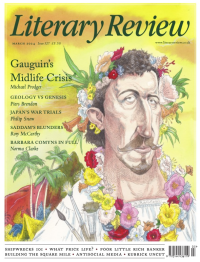Peter Moore
Mysteries of the Deep
A History of the World in Twelve Shipwrecks
By David Gibbins
Weidenfeld & Nicolson 304pp £25
A History of the World in Twelve Shipwrecks is a book of great range. It is possible, however, to identify its geographical heart. This is the Lizard peninsula at the western tip of Cornwall. Here, granite reefs lie in the coastal shallows, treacherous currents surge and capricious winds blow. It was off the Lizard in November 1721 that the Royal Anne Galley was ‘split to pieces on the Stag Rocks’ with the loss of all but three of the 210 aboard. It was there, during the most terrifying phase of the Battle of the Atlantic in 1941, that Richard Ayres, the second mate of the torpedoed SS Gairsoppa, scrambled ashore after a nightmarish fortnight at sea. And it was snorkelling in the shallows off the Lizard, in the summer of 2018, that the author and underwater archaeologist David Gibbins found himself gazing down in astonishment at a seabed ‘sparkling with gold’. Beneath him, he realised with a pang of delight, was the Mullion Pin Wreck.
The Lizard is a place Gibbins returns to again and again in this book, and it is worth picturing him at work there, kitted up in his diving gear, drifting on a current, his eyes darting across an archaeological site. This is very much the perspective of A History of the World in Twelve Shipwrecks, a book that takes readers beneath the waterline so they can experience the joy of discovery for themselves. The excitement of the pursuit is a sensation that has propelled Gibbins through a rich and adventurous career, during which he has worked on a series of shipwrecks. In his prologue, he is eager to stress that this book is a personal one. It is ‘a history’ rather than ‘the history’. The stories of the Royal Anne Galley, SS Gairsoppa and the Santo Cristo di Castello (or the Mullion Pin Wreck), along with the nine others that comprise Gibbins’s dozen, are ones with which he has personal connections.
This approach, of combining case studies to make a grand historical narrative, is not new. Several other books have used similar structural devices, among them Jerry Brotton’s cartographic history of the world, which was published with a near-identical title a decade ago. The form, however, is one that suits Gibbins’s

Sign Up to our newsletter
Receive free articles, highlights from the archive, news, details of prizes, and much more.@Lit_Review
Follow Literary Review on Twitter
Twitter Feed
It wasn’t until 1825 that Pepys’s diary became available for the first time. How it was eventually decrypted and published is a story of subterfuge and duplicity.
Kate Loveman tells the tale.
Kate Loveman - Publishing Pepys
Kate Loveman: Publishing Pepys
literaryreview.co.uk
Arthur Christopher Benson was a pillar of the Edwardian establishment. He was supremely well connected. As his newly published diaries reveal, he was also riotously indiscreet.
Piers Brendon compares Benson’s journals to others from the 20th century.
Piers Brendon - Land of Dopes & Tories
Piers Brendon: Land of Dopes & Tories - The Benson Diaries: Selections from the Diary of Arthur Christopher Benson by Eamon Duffy & Ronald Hyam (edd)
literaryreview.co.uk
Of the siblings Gwen and Augustus John, it is Augustus who has commanded most attention from collectors and connoisseurs.
Was he really the finer artist, asks Tanya Harrod, or is it time Gwen emerged from her brother’s shadow?
Tanya Harrod - Cut from the Same Canvas
Tanya Harrod: Cut from the Same Canvas - Artists, Siblings, Visionaries: The Lives and Loves of Gwen and Augustus John by Judith Mackrell
literaryreview.co.uk